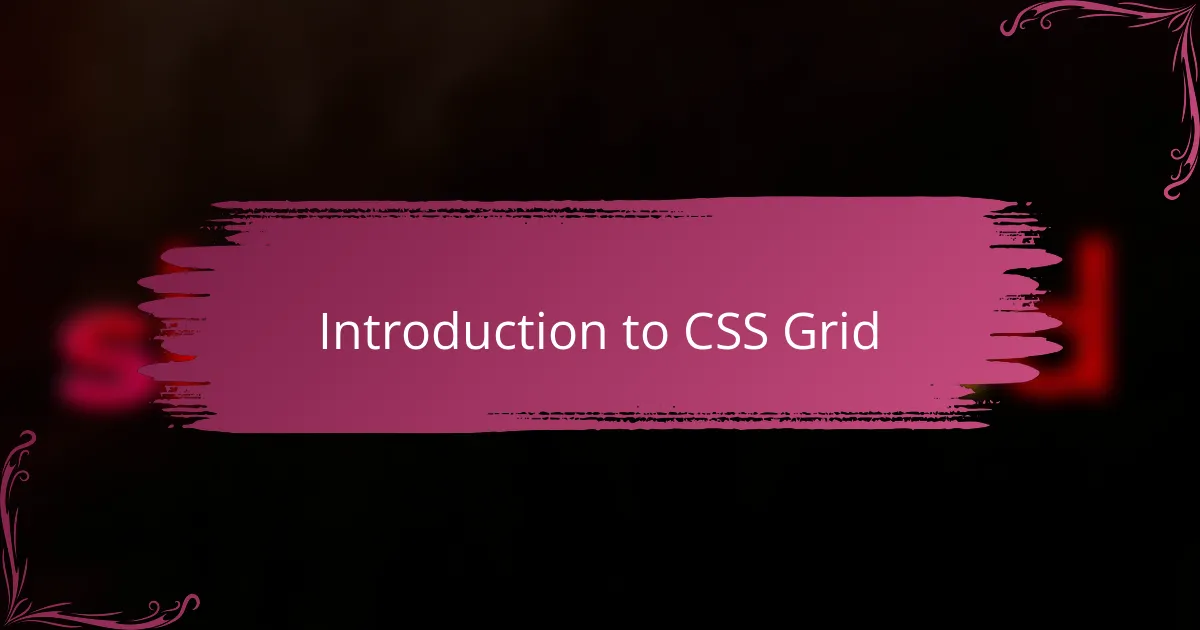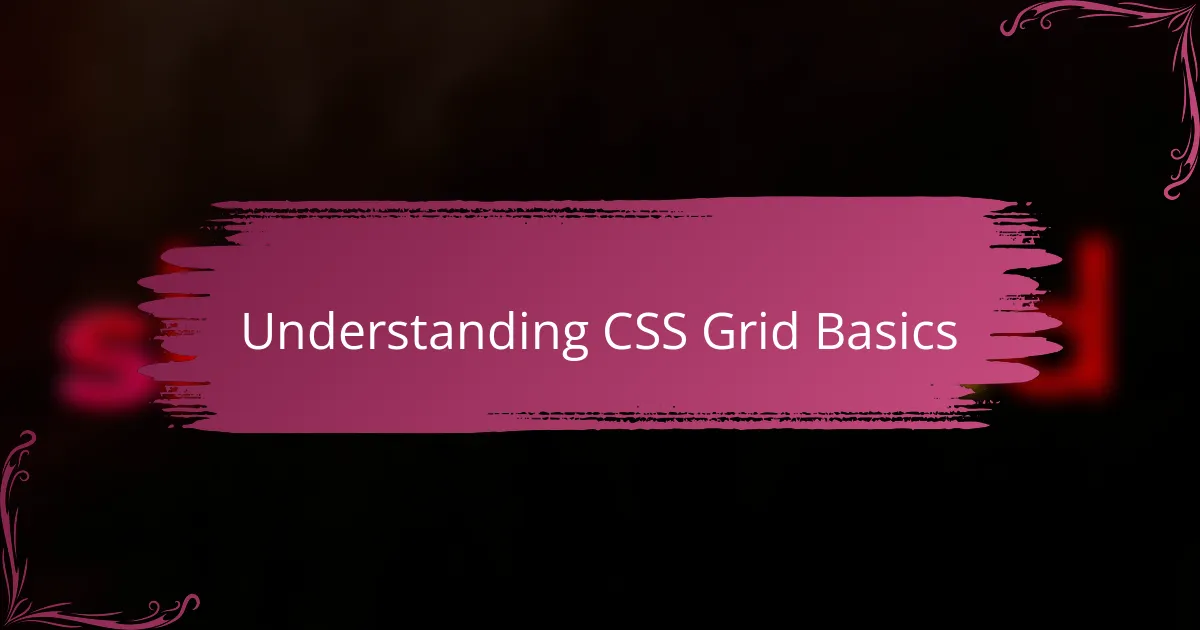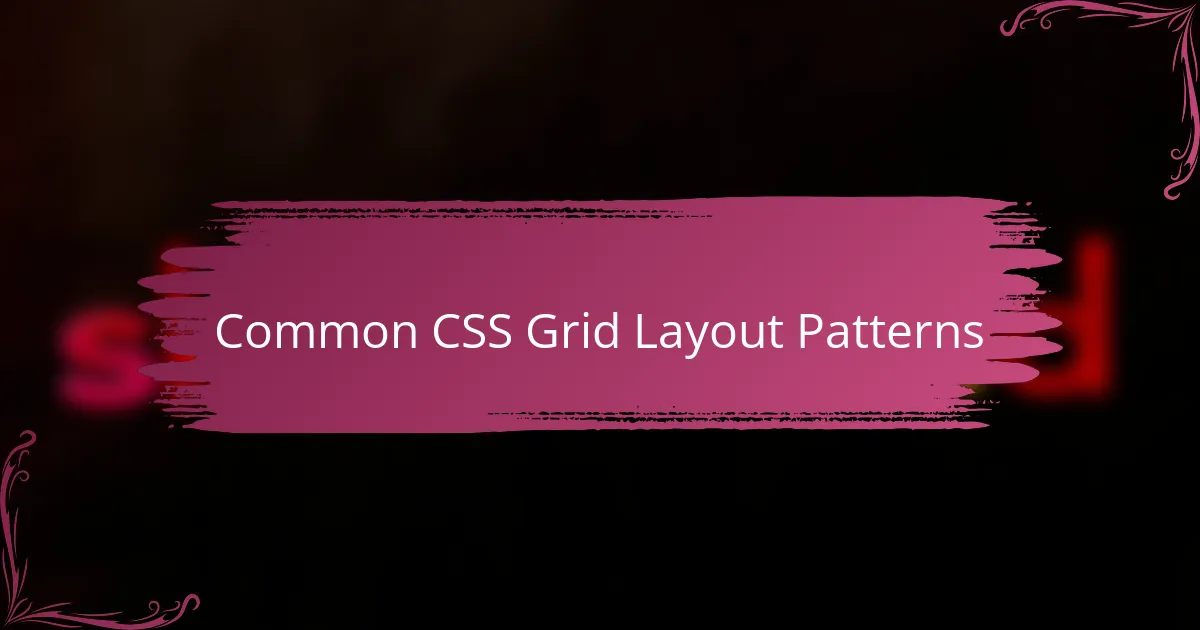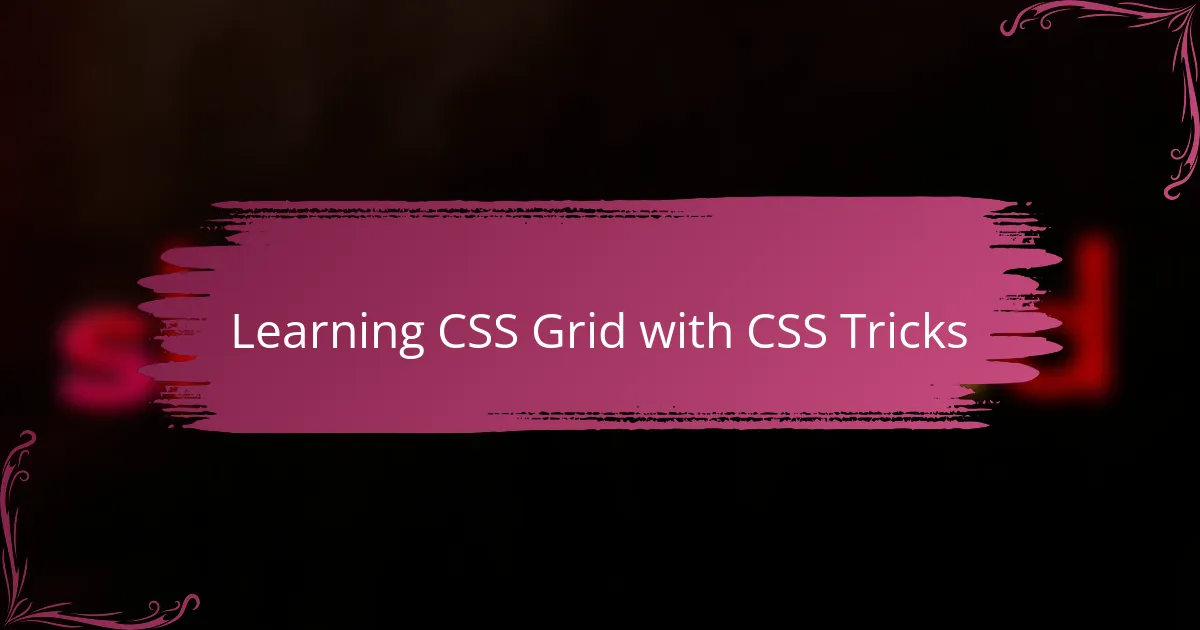Key takeaways
- CSS Grid simplifies layout design by allowing explicit definition of rows and columns, improving workflow efficiency.
- Essential properties like grid-template-columns, grid-template-rows, and grid-gap facilitate precise control over grid layouts and spacing.
- Common patterns such as two-column layouts and nested grids demonstrate the flexibility and power of CSS Grid for creating complex designs.
- Applying CSS Grid in real projects enhances responsiveness and maintainability, making layouts adapt seamlessly to different screen sizes.

Introduction to CSS Grid
When I first encountered CSS Grid, I was struck by how it completely transformed the way I approached layout design. It felt like discovering a new language that gave me the power to create complex, responsive structures with surprisingly simple code. Have you ever struggled with aligning elements in rows and columns, only to end up frustrated with hacks and workarounds? That’s exactly where CSS Grid shines.
CSS Grid allows you to define grids explicitly, breaking a page into rows and columns in a way that feels intuitive once you get the hang of it. I remember feeling a mix of excitement and confusion as I played around with properties like grid-template-columns and grid-gap—at first, the concepts seemed abstract, but hands-on practice quickly turned that around. It was like piecing together a puzzle where every part fit perfectly.
What makes CSS Grid so powerful, in my opinion, is how it shifts the focus from endless floats and positioning tricks to thinking structurally about your layout. It encourages a mindset where you design the whole page layout upfront, instead of trying to patch things together afterward. This shift alone made my workflow more enjoyable and efficient. Have you tried it yet? If not, get ready to change how you build web layouts forever.

Understanding CSS Grid Basics
Understanding CSS Grid starts with grasping its core concept: a grid made up of rows and columns that you explicitly define. I remember initially being puzzled by terms like “grid tracks” and “grid cells,” but once I visualized the layout as a flexible table, everything clicked. Have you ever thought about your webpage layout as a table that you control down to each cell? That perspective made CSS Grid feel so much more approachable to me.
One of the first things I learned was how properties like grid-template-rows and grid-template-columns let you set the size of these tracks precisely. At first, I worried I’d have to write complicated calculations, but using simple units like fractions (fr) and pixels helped me see the patterns emerge. Playing with these values became almost like solving a puzzle, adjusting sizes until the layout looked just right.
The beauty of CSS Grid lies in its ability to manage spacing effortlessly through properties like grid-gap. I used to spend ages struggling to get consistent gaps between elements, but with grid-gap, that problem vanished. Isn’t it amazing how a single property can save so much time and frustration? This straightforward control over spacing made my designs cleaner and my workflow smoother.

Essential CSS Grid Properties
When I first dug into essential CSS Grid properties, I found myself fascinated by grid-template-columns and grid-template-rows — these two really frame your entire layout. They let you specify how wide or tall each column or row should be, giving you precision that felt almost magical compared to my previous layout struggles. Have you noticed how setting these properties transforms the chaos of divs into a neat, predictable grid?
Another game-changer for me was the grid-gap property. Before, I would tediously add margins between elements, hoping things would line up perfectly. Using grid-gap was like breathing a sigh of relief; it handled spacing cleanly without extra fuss. Isn’t it surprising how such a simple property can save you from so much tedious tweaking?
Then there’s the display: grid declaration itself, which I realized is the gateway to unlocking all these powerful features. It took me a moment to remember to add it, but once I did, everything else followed naturally. It feels like switching a mode on—suddenly your container isn’t just a block anymore, it’s a full grid playground waiting to be customized. Have you had that moment when a small tweak leads to a big breakthrough? That’s exactly how I felt.

Common CSS Grid Layout Patterns
Some of the common CSS Grid layout patterns that really helped me grasp how flexible this tool is include the simple two-column layout and the classic masonry-style grid. When I first tried the two-column layout, it was like watching order emerge from chaos—content neatly aligned side by side without endless floats or clearfix hacks. Have you ever thought that something this straightforward could feel so satisfying?
The masonry pattern, on the other hand, challenged me to think differently about how items flow within the grid. It wasn’t just about rows and columns anymore; it was more organic and dynamic, which made me appreciate CSS Grid’s adaptability even more. Playing around with auto-placement and spanning items across multiple tracks gave me a real “aha” moment about grid’s potential.
Then there are nested grids, something I didn’t expect to use so soon but found incredibly powerful once I understood them. Creating a grid inside a grid felt a bit like inception—grids within grids! This layered approach opened up new possibilities for complex layouts without turning my code into a spaghetti mess. Have you ever felt impressed by how a single concept can unlock so many doors? That’s exactly what nesting did for me.

Practical CSS Grid Examples
I found that diving into practical examples really cemented my understanding of CSS Grid. Trying out a basic photo gallery layout, for instance, helped me see how easily grid-template-columns could create responsive rows without any complicated media queries. Have you ever been amazed at how just a few lines of grid code can produce such clean, adaptable designs?
Experimenting with dashboard layouts pushed my skills further. I played around with spanning grid items across multiple columns and rows, which initially felt tricky but soon became intuitive. Seeing content blocks resize and rearrange seamlessly left me thinking, “Why didn’t I learn CSS Grid sooner?”
One moment that stands out was building a blog layout with nested grids. It felt like unlocking a secret level—combining grids inside grids gave me granular control without the mess I used to dread. It was a real confidence boost, proving practical CSS Grid isn’t just theory; it’s a game changer for everyday coding.

Learning CSS Grid with CSS Tricks
One of the best things about learning CSS Grid through CSS Tricks was how clearly everything was explained. The step-by-step guides made what once seemed complicated suddenly feel manageable. Have you ever stumbled over a new concept only to find a resource that just clicks? That’s exactly what happened to me with the CSS Tricks tutorials.
I especially appreciated the real-world examples CSS Tricks provided. Seeing how grids could be applied to different layouts helped me connect the dots between theory and practice. It was like having a mentor walk me through each challenge, pointing out the little tricks that make a big difference.
What really stuck with me was how CSS Tricks encouraged experimentation. I remember tweaking grid properties, seeing instant visual feedback, and feeling that satisfying “aha” moment every time something aligned perfectly. Isn’t it great when learning feels more like play than work? That hands-on approach made mastering CSS Grid not just possible, but genuinely enjoyable.

Applying CSS Grid in Real Projects
Applying CSS Grid in real projects felt like stepping into a new dimension of layout freedom. I remember my first client website where I replaced clunky floats with a clean grid structure—it was so satisfying to see everything snap into place without endless tweaks. Have you ever built a page and thought, “There has to be a simpler way”? For me, CSS Grid was exactly that.
One challenge I faced was balancing grid complexity with maintainability. At times, I got carried away with spanning items and nested grids, only to realize simpler was better for both me and future developers. But that trial and error taught me how to apply CSS Grid thoughtfully, ensuring flexibility without chaos. Doesn’t that sound like a worthwhile trade-off?
What really amazed me was how quickly designs became responsive. Using fractional units and auto-placement meant layouts adapted elegantly to different screen sizes. I recall a project where a client was thrilled their site looked great on mobile without me writing a single media query—CSS Grid handled it beautifully. Have you experienced that kind of “set it and forget it” satisfaction in your coding?